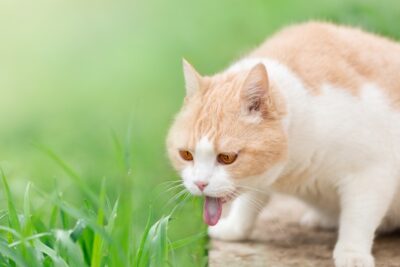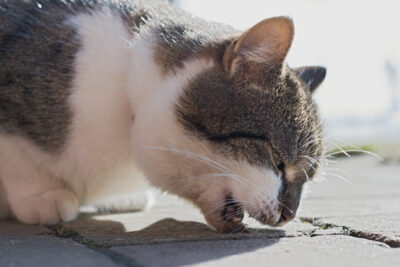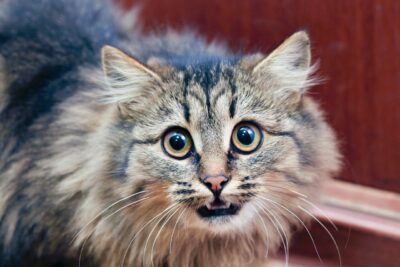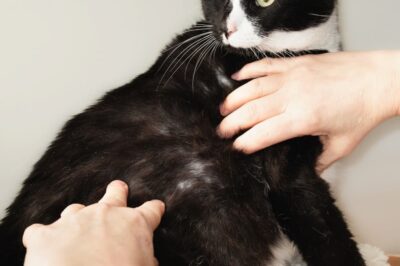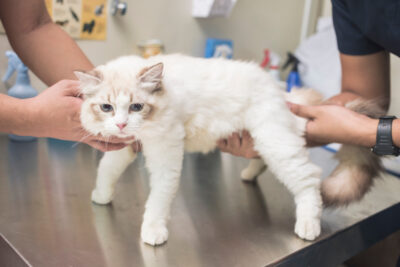Do Cats Get Motion Sickness?
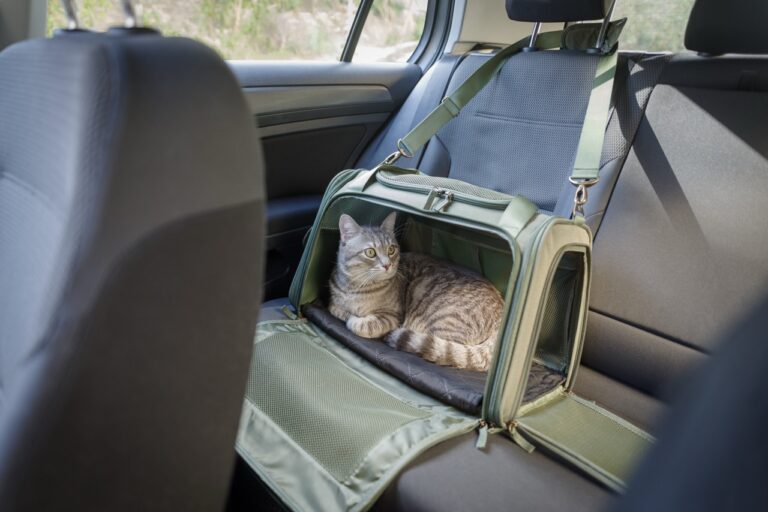
All featured products are chosen at the discretion of the GreatPetCare editorial team and do not reflect a direct endorsement by the author or reviewer.
You’re taking your cat to the vet when you look over and notice your pet drooling, panting, and shifting nervously in their carrier. You may wonder: Do cats get motion sickness? The answer is yes. Just like people, cats can feel queasy during car rides or other types of travel.
Motion sickness is especially likely in cats who are anxious or not used to traveling. But that doesn’t mean you and your kitty are destined to be home-bound.
Whether you’re taking a quick trip to the vet or a longer road trip, understanding what causes cat motion sickness can help you (and your cat) overcome it. We’ll teach you how to spot it and how to prevent it, so you can both travel easier.
Do Cats Get Motion Sickness? Here’s the Scoop
By now you know cats can get motion sickness. However, there’s a lot more to learn about this particular cat health concern than that.
First off, you should know that it can sometimes be hard to distinguish motion sickness from general nausea in cats. Feline nausea can be caused by many issues, like gastrointestinal problems, infections, or toxins.
The key difference is that feline motion sickness is nausea triggered by movement. It usually starts when a cat is in motion (e.g., in a moving vehicle) and stops soon after the movement ends.
Dr. Daniel Dixon, DVM, founder of North Keller Animal Hospital, explains that motion sickness can affect cats at any age. However, he says it’s more common in:
- Cats who weren’t introduced to car rides as kittens
- Cats with previous negative travel experiences
- Young cats, whose balance system is still developing
There’s no specific breed that’s more prone to motion sickness, but anxious cats may be more susceptible.
Is Motion Sickness the Same as Car Sickness?
For every pet parent that asks about motion sickness, there’s another asking, “Do cats get car sick?”
In cats, motion sickness and car sickness are essentially the same thing, though they may occur in different settings. Motion sickness is nausea triggered by movement, whether in a car, plane, or boat. Cat car sickness is simply motion sickness that occurs during a car ride.
Causes of Motion Sickness in Cats
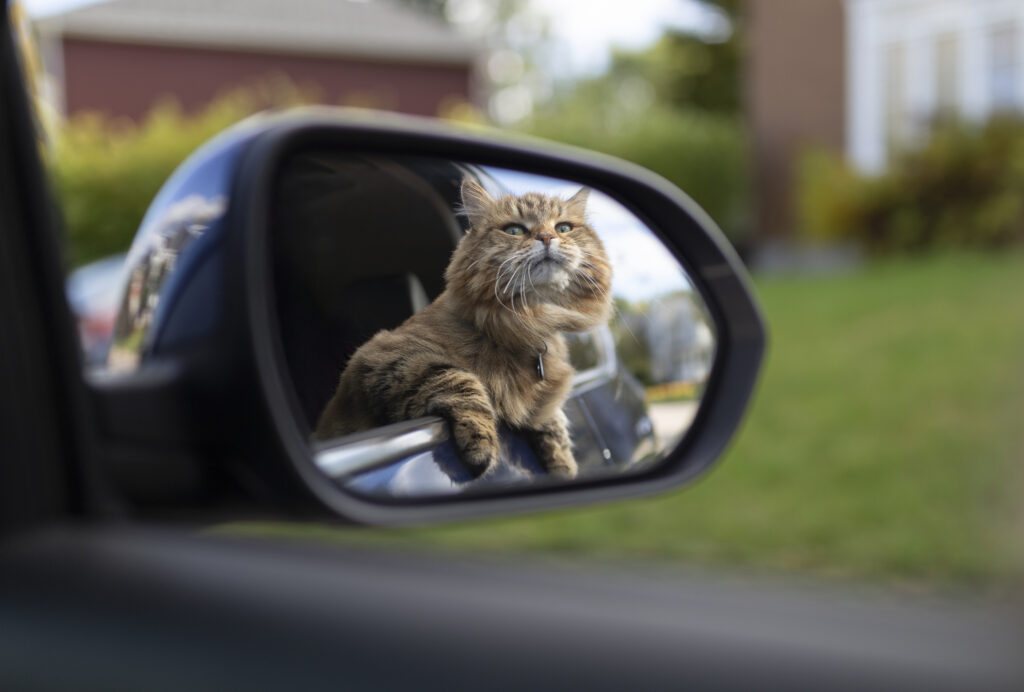
Several things can increase the risk of cat travel sickness. Here are some of the most common causes:
1. Sensory confusion (true motion sickness)
According to Dr. Dixon, true motion sickness starts in the inner ear — the area responsible for balance and detecting movement. Symptoms can occur when the brain receives mixed signals from this delicate sensor.
For example, the inner ear senses the car’s movement, but the eyes either don’t register it or interpret it differently. This disconnect between what the body feels and what the eyes see can confuse the brain and trigger nausea.
2. Stress and anxiety
“While the core of motion sickness is physiological, stress and anxiety can also play a role,” Dr. Dixon says.
If your cat isn’t used to car rides, they may get stressed out just by being in the car. Other cats may start to associate stressful experiences, like a visit to the vet, with the car-ride leading up to it.
Dr. Dixon explains that this learned link can cause motion sickness symptoms from stress and anxiety, sometimes triggered simply by being placed in a carrier.
3. Inner ear problems
Medical issues affecting the inner ear, such as vestibular disease, can throw off your cat’s sense of balance. This makes them more sensitive to movement and increases the likelihood of motion sickness.
If your cat suddenly starts showing signs of travel sickness, have your vet rule out underlying health issues to ensure that’s not the culprit.
Cat Car Sickness Symptoms
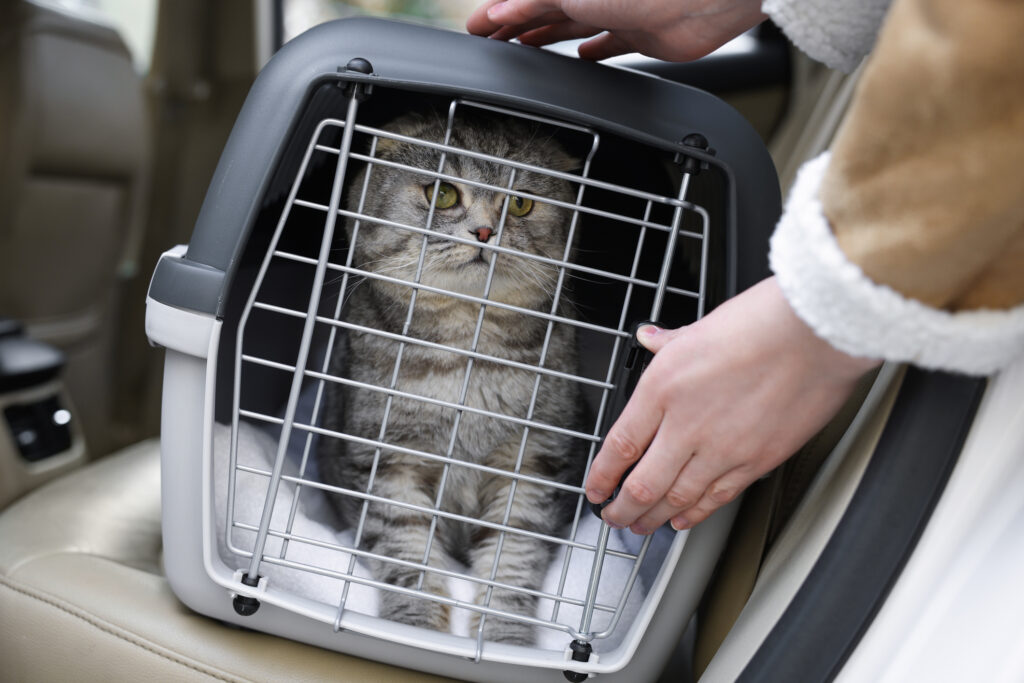
Motion sickness in cats can show up in a variety of ways, from physical to behavioral. Signs to watch for include:
- Cat drooling in car
- Vocalizing (meowing, howling, or crying)
- Panting
- Retching or gagging
- Vomiting
- Lethargy, weakness, or listlessness
- Restlessness or pacing
- Lip licking or frequent swallowing
- Frequent yawning
Motion sickness symptoms often resemble general nausea, but the key difference is when they occur. If your cat shows symptoms only during car rides and recovers soon after, motion sickness is the likely culprit. If the symptoms continue once the trip is over or at random times, another health issue may be to blame and should be checked by a vet.
These signs can often accompany general nausea in cats, as well. But if the symptoms only happen during car rides and go away afterward, motion sickness is likely the cause.
If the symptoms continue once the trip is over or at random times, another health issue may be to blame. Contact your vet to discuss your concerns and arrange for a health check.
Cat Motion Sickness Treatment
If your cat starts showing signs of motion sickness, such as drooling, panting, or vomiting, there are several ways you can help ease their discomfort during the ride:
Tips to help a cat with car sickness
- Take a break: If possible, stop the car so your cat gets a break from the movement. This can help settle their symptoms, especially if they are severe.
- Open a window slightly: A bit of fresh air and airflow can help reduce nausea and keep your cat more comfortable.
- Speak calmly and gently: Reassuring your cat in a soft voice can help ease their stress, which may lessen symptoms tied to anxiety.
- Keep the car cool and quiet: Lower the temperature and avoid loud music or sudden noises. A calm environment can make a big difference in how your cat handles travel.
- Avoid taking them out of the carrier: Even if they seem distressed, it’s safer to keep your cat secured in their carrier. Opening the door during a trip can be dangerous and may increase stress if they try to escape.
- Cover the carrier: Drape a light blanket over the carrier to help block out visual stimulation that can trigger cat nausea. Just make sure there’s plenty of airflow for your car sick cat.
Medication for motion sickness in cats
While in-the-moment strategies can help ease symptoms, the most effective way to manage motion sickness is to prevent it altogether. In severe cases, motion sickness medication for cats may be an important part of your pet’s prevention plan.
Below are some medications veterinarians often prescribe to help prevent motion sickness in cats:
Cerenia (maropitant citrate): This commonly prescribed anti-nausea medication works by blocking the brain’s vomiting signals. Note that Cerenia tablets are only FDA approved for use in dogs, but many vets prescribe them “off-label” for use in cats.

Dramamine (dimenhydrinate): This antihistamine medication for humans is sometimes used off-label in cats to prevent motion-induced nausea. While it’s available over the counter, you should never use Dramamine for cats without veterinary approval and supervision.
Meclizine: Also an antihistamine, this medication is used off-label to manage motion-related nausea in cats.
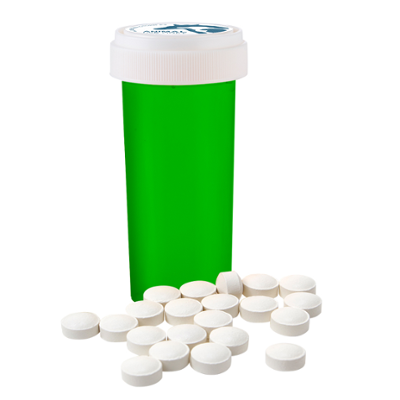
Gabapentin: While not an anti-nausea drug, it’s often prescribed off-label for anxious cats. It can help reduce stress that contributes to motion sickness.

Most of these medications need to be given an hour or two prior to travel to be effective. Make sure to speak with your veterinarian about when to administer the medication before traveling.
How to Prevent Cat Motion Sickness
While not every case can be prevented, there are many ways to reduce the risk of cat motion sickness.
Here are some tips that can help make travel a more comfortable experience for your cat:
- Start young, if possible. Dr. Dixon says that cats who are introduced to car rides as kittens are less likely to develop motion sickness later in life.
- Use desensitization therapy. Gradually introduce your cat to car travel using a staged approach. Dr. Dixon suggests starting at home by making the carrier a positive space with comfortable bedding, treats, and toys. Once your cat is comfortable using the carrier at home, try it out in a parked car. Then progress to short drives. Be sure to reward your cat after each session to build a positive association.
- Don’t feed right before travel. Avoid feeding your cat for a few hours before a trip to reduce the chance of nausea, vomiting, and accidents.
- Use a secure, forward-facing carrier: A stable, well-ventilated carrier that faces forward can help reduce motion-related disorientation.
- Block out visual cues. Cover the carrier to block moving scenery, which can make motion sickness worse.
- Try a pheromone spray. Using a pheromone spray like Feliway Travel Spray in your cat’s carrier before placing them inside may help reduce anxiety.
- Create a calm environment. Keep the car at a comfortable temperature and minimize noise for a soothing ride.
- As your vet about cat motion sickness medicine. For cats with a history of car sickness, your vet might recommend anti-nausea medication, anti-anxiety medication, or both (especially for longer trips).
Help Your Cat Find Their Travel Groove
Motion sickness in cats can be frustrating, but it’s manageable. By staying alert for symptoms and responding to your cat’s cues, you can help your cat feel better during car rides.
The secret is finding out which solutions work best for your feline friend. Whether it’s covering the carrier, using desensitization techniques, or talking to your vet about cat motion sickness medication, small steps can add up to a calmer, more comfortable ride for all.
